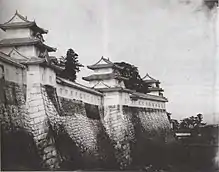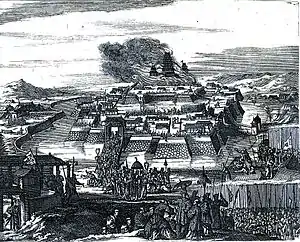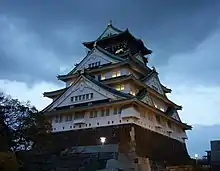| Osaka Castle 大坂城 | |
|---|---|
| Osaka, Japan | |
 ・
| |
| Type | Azuchi-Momoyama castle |
| Site information | |
| Condition | Reconstructed |
| Site history | |
| Built | 1583 |
| Built by | Toyotomi Hideyoshi |
| In use | 1583–1845 |


Osaka Castle (大坂城 or 大阪城, Ōsaka-jō) is a Japanese castle in Chūō-ku, Osaka, Japan. The castle and fortress are one of Japan's most famous landmarks and it played a major role in the unification of Japan during the sixteenth century of the Azuchi-Momoyama period.[1]
Layout
The main keep of Osaka Castle is situated on a plot of land roughly one square kilometre. It is built on two raised platforms of landfill supported by sheer walls of cut rock, using a technique called burdock piling, each overlooking a moat. The keep is five stories on the outside and eight stories on the inside and built atop a tall stone foundation to protect its occupants from attackers.
The main keep is surrounded by a series of moats and defensive fortifications. The castle has two moats (an inner & outer). The inner castle moat lies within the castle grounds and consists of two types: a wet (northern-easterly) and dry (south-westerly). The outer moat meanwhile surrounds the entire castle premise, denotes the castle's outer limits, and consists of four individual water-filled sections, each representing a cardinal direction (North, East, South, West).
The castle grounds, which cover approximately 61,000 square metres (15 acres), contain the following thirteen structures that were denoted as "important cultural assets" by the Japanese government:[2]
- Ote-mon Gate
- Sakura-mon Gate
- Ichiban-yagura Turret
- Inui-yagura Turret
- Rokuban-yagura Turret
- Sengan Turret
- Tamon Turret
- Kinmeisui Well
- Kinzo Storehouse
- Enshogura Gunpowder Magazine
- Three sections of castle wall all located around Otemon Gate
- Megaliths at the castle include the Octopus stone.
The outer moat has two main sentry checkpoints: the Aoyamon Gate (in the north-east) and the Otemon Gate (in the opposing south-west).
Between the outer and inner moat are the following: Fushimi-yagura Turret Remains, Ensho-gura Gunpowder Storehouse, Osaka Geihinkan, Hoshoan Tea House, Osaka Castle Nishinomaru Garden, Sengan-yagura Turret, Tamon-yagura Turret, Remains of Taiko-yagura Turret, Osaka Shudokan Martial Arts Hall, Hokoku Shrine (Osaka), Ichiban-yagura Turret (The first turret), and Plum Grove.
There are two places to cross the inner moat, Gokuraku-bashi Bridge (located in the North) and Sakuramon Gate (main sentry point in the South).
Within the inner moat, the castle was divided into two major areas: the Hommaru (Inner Bailey) and the Yamazato-Maru Bailey. Located within the Hommaru is the Main Tower, the Kimmeisui Well, the Japanese Garden, the Takoishi (Octopus Stone), the Gimmeisui Well, the Miraiza Osakajo Complex, the Kinzo Treasure House, and the "Timecapsule Expo'70". While within the Yamazato-Maru Bailey consists of the Marked-Stones Square, and the Monument commemorating 'Hideyori and Yodo-dono committing suicide'.
History
.jpg.webp)



In 1583 Toyotomi Hideyoshi commenced construction on the site of the Ikkō-ikki temple of Ishiyama Hongan-ji.[3] The basic plan was modeled after Azuchi Castle, the headquarters of Oda Nobunaga. Hideyoshi wanted to build a castle that mirrored Nobunaga's but surpassed it in every way: the plan featured a five-story main tower, with three extra stories underground, and gold leaf on the sides of the tower to impress visitors. In 1585 the Inner donjon was completed. Hideyoshi continued to extend and expand the castle, making it more and more formidable to attackers. In 1597 construction was completed and Hideyoshi died the year after. Osaka Castle passed to his son, Toyotomi Hideyori.
In 1600 Tokugawa Ieyasu defeated his opponents at the Battle of Sekigahara and started his own bakufu (i.e., shogunate) in Edo. In 1614 Tokugawa attacked Hideyori in the winter, starting the Siege of Osaka.[4] Although the Toyotomi forces were outnumbered approximately two to one, they managed to fight off Tokugawa's 200,000-man army and protect the castle's outer walls. Ieyasu had the castle's outer moat filled, negating one of the castle's main outer defenses.
During the summer of 1615, Hideyori began to restore the outer moat. Ieyasu, in outrage, sent his armies to Osaka Castle again, and routed the Toyotomi men inside the outer walls on June 4.
Osaka Castle fell to the Tokugawa clan, the Toyotomi clan perished, Hideyori and Yodo-dono committed seppuku and the castle buildings burned to the ground.[3]: 153
In 1620, the new heir to the shogunate, Tokugawa Hidetada, began to reconstruct and re-arm Osaka Castle. He completely buried the Toyotomi version of the castle with the new castle. [5] He assigned the task of constructing new walls to individual samurai clans. The walls built in the 1620s still stand today and are made out of interlocked granite boulders without mortar. Many of the stones were brought from rock quarries near the Seto Inland Sea and bear inscribed crests of the various families who contributed them.
Tokugawa also built a new elevated main tower, five stories on the outside and eight stories on the inside. Construction of the tenshu started in 1628 and was completed 2 years later, about the same time the rest of the reconstruction, and followed the general layout of the original Toyotomi structure.[3]: 153–157 However, it was built in a different part of the Honmaru (main bailey), as the base of the Toyotomi keep had actually been buried by the new Tokugawa version of the castle. [6]
In 1660, lightning ignited the gunpowder warehouse and the resulting explosion set the castle on fire. In 1665, lightning struck and burnt down the tenshu.[3]: 157
Kajisuke Nakama was one of the hatamoto guards that protected Osaka Castle. On 15 May 1740, when he was 25-year-old, he stole 4,000 ryo of gold inside. However, the crime was soon discovered by the shogunate, so he was arrested and confessed. Although he was a samurai, he was dragged around the city and sentenced to crucifixion in September. Later, this incident became a legend and the contents changed, so it is said that he was a thief who wanted the gold that Toyotomi Hideyoshi had dropped in the Kinmeisui Well.
In 1843, after decades of neglect, the castle got much-needed repairs when the bakufu collected money from the people of the region to rebuild several of the turrets.
In 1868, Osaka Castle fell and was surrendered to anti-bakufu imperial loyalists. A number of the castle buildings were burned in the civil conflicts surrounding the Meiji Restoration.[3]: 157 The Honmaru Palace was lost during the Boshin War. In its place the Kishū Palace (紀州御殿 Kishū Goten) was moved here from Wakayama Castle to serve as an imperial state guest house, named later Tenrinkaku.[7][8][9][10]
Under the Meiji government, Osaka Castle became part of the Osaka Army Arsenal (Osaka Hohei Kosho) manufacturing guns, ammunition, and explosives for Japan's rapidly expanding Western-style military.[11]
In 1931, the ferroconcrete tenshu was built.[3]: 157

During World War II, the arsenal became one of the largest military armories, employing 60,000 workers.[11] American bombing raids targeting the arsenal damaged the reconstructed main keep and, on August 14, 1945, destroyed 90% of the arsenal and killed 382 people working there.
In 1995, Osaka's government approved yet another restoration project, with the intent of restoring the main keep to its Edo-era splendor. In 1997, restoration was completed. The keep is a concrete reproduction (including elevators) of the original and the interior is intended as a modern, functioning museum.
Located in the Nishinomaru was the former residence of the jōdai, who were officials. The residence was the second largest after the Honmaru Palace. North of it were a number of warehouses. The site is now a park. Next to it is the Osaka State Guest House and the Hōshō-an chashitsu.
Views of the castle
 Osaka Castle at night
Osaka Castle at night Osaka Castle pedestrian entrance
Osaka Castle pedestrian entrance Main keep
Main keep Otemon (western) Gate
Otemon (western) Gate Early representation of the destruction of the 1663 François Caron book
Early representation of the destruction of the 1663 François Caron book.jpg.webp) From the roof of Osaka Castle main tower
From the roof of Osaka Castle main tower Prunus mume grove in Osaka Castle Park
Prunus mume grove in Osaka Castle Park Outer moat and Osaka Business Park
Outer moat and Osaka Business Park Cherry blossom at Osaka Castle
Cherry blossom at Osaka Castle Osaka Castle during twilight
Osaka Castle during twilight Tenshu of Osaka Castle
Tenshu of Osaka Castle Osaka Castle from 1583 until 1615
Osaka Castle from 1583 until 1615 Osaka Castle from 1620 until 1868
Osaka Castle from 1620 until 1868.jpg.webp) Outer-View of Aoyamon Gate
Outer-View of Aoyamon Gate.jpg.webp) Inner moat ramparts viewed from inner Aoyamon Gate
Inner moat ramparts viewed from inner Aoyamon Gate.jpg.webp) Main keep from Gokuraku Bashi (bridge)
Main keep from Gokuraku Bashi (bridge).jpg.webp) Main keep from Marked Stone Square
Main keep from Marked Stone Square.jpg.webp) Main keep from Uzumimon Gate
Main keep from Uzumimon Gate.jpg.webp) View of moat from atop Uzumimon Gate
View of moat from atop Uzumimon Gate.jpg.webp) Main keep from Miraiza Building
Main keep from Miraiza Building.jpg.webp) Inner-view of Sakuramon Gate
Inner-view of Sakuramon Gate.jpg.webp) Easterly view of dry inner moat outside Sakuramon Gate
Easterly view of dry inner moat outside Sakuramon Gate.jpg.webp) Gozabune boat ferrying tourists around on the inner moat.
Gozabune boat ferrying tourists around on the inner moat.
Access
The castle is open to the public and is easily accessible from Osakajōkōen Station on the JR West Osaka Loop Line. It is a popular spot during festival seasons, and especially during the cherry blossom bloom (hanami), when the sprawling castle grounds are covered with food vendors and taiko drummers. The large indoor arena, Osaka-jō Hall, also is located within the grounds of the castle park.
In popular culture
- In the 1955 Toho tokusatsu film Godzilla Raids Again, Godzilla's battle with Anguirus leads onto the castle grounds. The structure itself collapses when Godzilla pins Anguirus against it.
- in the 1966 tokusatsu film, Gamera vs. Barugon, the titular monsters' first encounter is at the site of the castle.
- The castle appears in The iconic two-parter of the iconic 1966 tokusatsu television series, Ultraman where the titular hero does battle with the monster Gomora on the castle grounds.
- In 1975, British novelist James Clavell used the castle and its environs (c. 1600) as a major plot location for his most famous work of historical fiction, Shōgun.
- The castle was featured in the finale of The Amazing Race 20, where it hosted a Pit Stop.[12]
- In the 2002 film Suicide Club, it is reported that 200 high school girls jumped off the Osaka Castle.
See also
References
- ↑ "Uemachidaichi : OSAKA-INFO – Osaka Visitor's Guide". Osaka-info.jp. Archived from the original on December 28, 2012. Retrieved 2013-02-15.
- ↑ "Osaka Castle". GoJapanGo. Archived from the original on 2017-06-17. Retrieved 2010-10-08.
- 1 2 3 4 5 6 Hinago, Motoo (1986). Japanese Castles. Kodansha International Ltd. and Shibundo. p. 153. ISBN 0870117661.
- ↑ Meek, Miki. "The Siege of Osaka Castle". National Geographic Magazine. Archived from the original on January 27, 2008. Retrieved 2008-01-22.
- ↑ https://archaeology.jp/sites/2011/ishikiri.htm
- ↑ https://archaeology.jp/sites/2011/ishikiri.htm
- ↑ https://www.sankei.com/article/20220722-NPS2IU72EBNN3KLXMDSOTPIS2Q/
- ↑ https://osaka-castle.net/osakajo/honmarugotenato-kisyugotenato.html
- ↑ https://www.mlit.go.jp/tagengo-db/common/001554774.pdf
- ↑ https://crd.ndl.go.jp/reference/modules/d3ndlcrdentry/index.php?page=ref_view&id=1000286319
- 1 2 "Osaka Army Arsenal". Ndl.go.jp. Archived from the original on 2013-02-09. Retrieved 2013-02-15.
- ↑ Jacobson, Jennifer (May 7, 2012). "The Amazing Race recap: It's a beautiful place to become millionaires". The Birmingham News. Retrieved December 31, 2019.
Literature
- Benesch, Oleg. "Castles and the Militarisation of Urban Society in Imperial Japan," Transactions of the Royal Historical Society, Vol. 28 (Dec. 2018), pp. 107–134.
- Benesch, Oleg and Ran Zwigenberg (2019). Japan's Castles: Citadels of Modernity in War and Peace. Cambridge: Cambridge University Press. p. 374. ISBN 978-1108481946.
- De Lange, William (2021). An Encyclopedia of Japanese Castles. Groningen: Toyo Press. p. 600. ISBN 978-9492722300.
- De Lange, William. (2022). The Siege of Osaka Castle: The Winter and Summer Campaigns. Groningen: Toyo Press. ISBN 978-9492722386
- Mitchelhill, Jennifer (2013). Castles of the Samurai: Power & Beauty. US: Kodansha. ISBN 978-1568365121.
- Schmorleitz, Morton S. (1974). Castles in Japan. Tokyo: Charles E. Tuttle Co. pp. 69–78. ISBN 0804811024.
- Motoo, Hinago (1986). Japanese Castles. Tokyo: Kodansha. p. 200. ISBN 0870117661.
External links
 Media related to Osaka Castle at Wikimedia Commons
Media related to Osaka Castle at Wikimedia Commons- Official website
 (in English)
(in English)
